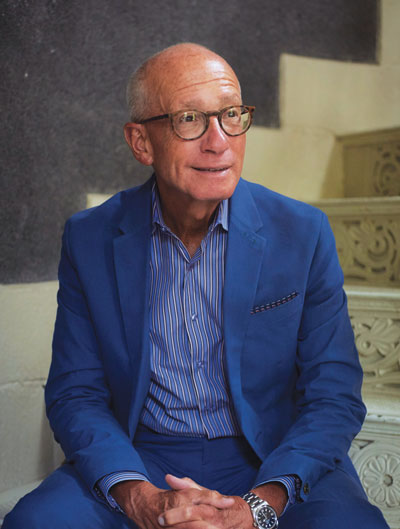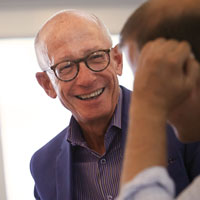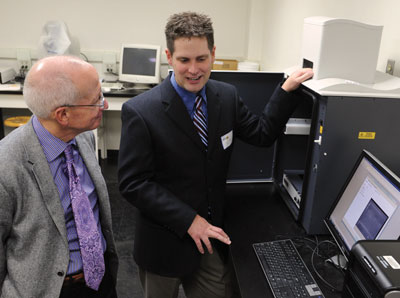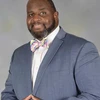
Not a day goes by that Fredonia doesn’t benefit from Christopher Mirabelli.
In fact, he’s positively impacted its students and faculty every day for the last six years. That’s when this member of the Class of 1977 stepped forward to fund a much-needed Syngene imager for the biology department. The gel documentation system, which was state-of-the-art when the $20,000 tool was purchased in 2009, allows faculty and students to photograph DNA and protein samples.
“It’s used by almost every faculty member in the department and figures prominently in no fewer than five different laboratory courses,” attests Biology Assistant Professor Scott Ferguson. “It’s used on a daily basis by our students and faculty to meet a variety of learning and research goals. Without Chris’ generosity, this wouldn’t have happened.”
That sentiment is echoed even louder by Kaitlyn Crossan. The 2015 graduate just started medical school, thanks to a scholarship Dr. Mirabelli established.
“I cannot tell you how grateful I am,” says Ms. Crossan, one of three Fredonia students to earn the 2015 SUNY Chancellor’s Award for Excellence. “It allowed me to receive a top-notch education at Fredonia and enter medical school debt free.”
As impressive as his impact on Fredonia has been, it pales in comparison to the numbers of people Dr. Mirabelli has helped throughout his 35-year career in pharmaceutical research and development (R&D).
Mirabelli has played a meaningful role, from a variety of aspects, in the development of ground-breaking medicines to treat such debilitating or deadly diseases and conditions as leukemias and lymphomas, multiple myeloma and other cancers, as well as inflammatory bowel disease, multiple sclerosis and familiar amyloidosis. Along the way, he’s directed an R&D department within pharmaceutical “A-lister” Smith, Kline & French (now GlaxoSmithKline), co-founded and led his own pharmaceutical companies, and helped dozens of next-generation pharmaceutical start-ups in their quest to save and improve lives.
Yet, like his attitude toward his generosity, any discussion with him about his career accomplishments are met with great humility.
“No one can really take credit for any one drug, because it’s such a long process, and so many people are involved to bring each one to market,” Mirabelli insists.
Fredonia’s Influence
So how did he go from the laboratories of Jewett Hall to those of health care’s biggest and brightest? He credits a variety of mentors and fortunate circumstances for leading him down his rewarding path.
He grew in up in Bellport, N.Y., on the south central Long Island shore. After completing a degree at Suffolk Community College, he knew he wanted to get involved in the sciences in some way at a four-year university, but he wasn’t exactly sure of the specifics yet.
“I thought I might like being a dentist,” he recalls of his decision to choose Fredonia as his next step, even though it was on the other side of the state. “Fredonia was intriguing,” he says, because it wasn’t a large university, he had some friends who were already attending, and it had good science programs.
He expanded his career possibilities shortly after he arrived, thanks to the influence of two key faculty members.
The first was SUNY Distinguished Teaching Professor Kevin Fox, whom Chris credits for “really getting (me) excited about science” during his first animal behavior course.
But it was Dr. Wayne Yunghans who turned Chris on to the world of scientific research, allowing him the chance to explore and gain some intellectual independence. Dr. Yunghans quickly recalls the transformation he witnessed within Mirabelli.
“Chris was an excellent student who just needed some direction and incentive,” he explains. “He took on the undergraduate research work in my lab and enjoyed the challenge. He worked well with the other friends in the lab and was a great person to have doing experiments. I enjoyed having him as a research student and I am really happy that he has had such a successful career.”
Dr. Fox also remembers the extraordinary focus Chris developed at Fredonia.
“As an undergraduate, Chris exhibited remarkable comprehension of scientific content,” he says. “He immersed himself in his studies to the extent that he spent much of his non-class time visiting with our faculty and graduate students, discussing their research and current science. When Chris graduated from Fredonia, it was clear that he had prepared himself exceptionally well for a career in science.”
Despite that preparation, Mirabelli still wasn’t sure exactly what he wanted to do, so he returned home to Long Island — but kept his research interests alive through a position with Brookhaven National Laboratory while he figured that out.
He found his answer, surprisingly, in North Carolina — in a random hallway at Duke University. Two Fredonia friends had been accepted into graduate school there, and Chris had helped them move.
“I was just walking around the hallways of Duke’s biochemistry department, and I saw a flyer for the Molecular Pharmacology program at Baylor College of Medicine,” he says. “It looked interesting, so I applied.”
That would be the first of a number of fortunate circumstances that Chris would take advantage of throughout his career.
When he arrived at Baylor he quickly formed a bond with his advisor, an oncologist named Dr. Stanley Crooke, who directed a sizable portion of the oncology research efforts for pharmaceutical giant Bristol-Myers. One of Crooke’s initiatives included establishing a Bristol-Myers lab on the Baylor campus, so that its graduate students could be involved with the development of various Bristol-Myers drugs and the university’s research efforts would, in turn, benefit from the company’s funding.
Opportunity Knocks
Toward the end of Mirabelli’s time at Baylor, Crooke was recruited to Bristol-Myers rival Smith Kline & French (SK&F), opening a door for Chris immediately after he finished his Ph.D. Mirabelli was hired to help Crooke start the Molecular Pharmacology department inside SK&F in 1981, eventually becoming head of a department within the Philadelphia-based company’s R&D division.
“It was an exciting time, because while pharmaceutical companies had R&D departments for a long time, the advent of molecular biology was changing everything,” Chris recalls. “We had a chance to now study diseases at the molecular level. The idea was to create a department inside of SmithKline that would marry the more ‘classic’ pharmacology departments with the molecular biology and genetic engineering that was just now being introduced to the industry.”
Mirabelli’s time at SK&F was mostly focused on the areas of oncology, inflammatory disease, and infectious disease, not only on the discovery side of things, but also as they transitioned into development. One of his biggest projects on the discovery side that he worked on was a drug that became known as Topotecan, used to treat ovarian and lung cancer, as well as other cancer types.
Starting Up a Start-Up

His relationship with Crooke remained strong throughout his tenure at SK&F, and when Crooke began considering a leap into entrepreneurship in the late 1980s, Mirabelli was a natural partner. They added a third colleague and in 1989 formed Isis Pharmaceuticals, named after the Egyptian goddess of magical healing. Chris and his wife, Catherine, relocated to San Diego with the team, which raised money through venture capital firms, despite being relatively uninformed about what it took to be a successful entrepreneur.
“I didn’t even know what the heck a venture capitalist was until I was introduced to one,” Mirabelli laughs. “If I had known what I didn’t know at the time, I probably would not have done it (started the business).”
Nonetheless, the company quickly gained financial backers and a great deal of traction as they worked in novel areas of pharmaceutical development. In addition to being the executive vice president for research and preclinical development, Chris became involved in many of the tactical operations, including human resources and facilities and laboratory build out. They went from being three people to roughly 100 in just over two years. They formed partnerships with many U.S., European and Japanese pharmaceutical companies, and were ready to file the first Investigational New Drug (IND) application for an oligonucleotide drug. Mirabelli and the team then took the company public, and the NASDAQ-listed company just celebrated its 25th anniversary.
Family Ties Win Out
However, after Catherine gave birth to their son, Gabriel, the East Coast natives began missing their families back home in New York and Philadelphia. It wasn’t long before they realized they wanted to move back east.
As luck would have it, another opportunity presented itself. An executive with Boston’s HealthCare Ventures, a venture capital firm specializing in the pharmaceutical industry, gave Chris a call in 1993.
“They were searching for someone to be the founding Chief Executive Officer of a new company that they were starting with a Harvard University professor who specialized in immunology,” Mirabelli explains.
The company, LeukoSite, went public in 1997 and would see several white-blood-cell-targeted drugs in its pipeline eventually make it to market, following its merger with Millennium Pharmaceuticals in 1999. Mirabelli looks back on that experience with great satisfaction.
“I tell people it’s kind of the ‘trifecta’ in our business,” he says. “You make drugs that have a very positive impact on people’s lives; you make money for your investors, which is what fuels the pharmaceutical industry; and you get the chance to do really good science.”
Trading Lab Coats for Suit Coats

Biology Professor Scott Ferguson shows Dr. Mirabelli the new Syngene imager which he donated to the department. Used daily, the imager photographs DNA and protein samples, allowing students and faculty to conduct research which they could not consider previously.
Today, Mirabelli sits on the other side of the table that he was so often at as a researcher and developer, serving as managing director for HealthCare Ventures — the same Cambridge, Mass. firm which recruited him to Boston over two decades ago. He says his experience in the lab and in recognizing the kinds of people who have what it takes to succeed has proved invaluable.
“We’re not reactive or passive investors; we go out and find those next success stories,” he says, adding that having the proper management team in place is often more important to a company’s success than the science itself.
In addition to the financial support Chris gives to the many scientific hopefuls who walk through his doors, he also offers lessons learned when he was in their shoes.
“Because it (drug development) is such a long and complicated process, it requires a lot of really smart people from different disciplines,” Mirabelli advises. “One of the things I was able to take advantage of, starting when I was at SmithKline, was the ability to go out and find mentors.
“Go some place and identify the two or three people that you really want to learn from, and find ways to interact with them to give you some of their experience,” he adds. “Obviously there’s a lot of time that goes into this business, and a lot of experience is needed — and one great way to speed that process up is by learning from others.”
The Fredonia Factor
Chris’ path back to Fredonia was the result of another fortunate — and downright funny — coincidence. He hadn’t stayed in contact with his undergraduate alma mater since his days in Western New York. However, that changed in 2005 when he began working with fellow Fredonian Jeffery Kelly, ’82, to provide funding for Dr. Kelly’s company, FoldRx. The initiative led to the discovery of a drug that cures a rare amyloid liver disease, part of a class of diseases that includes Alzheimer’s. The drug was so full of potential that pharmaceutical giant Pfizer acquired FoldRx in 2010.
Kelly and Mirabelli had worked together for about 18 months before they realized their connection.
“I finally took a closer look at his CV (curriculum vitae) before a talk he was about to give, and I saw it,” Mirabelli laughs. “I guess it just never came up before.”
Kelly had already re-engaged with Fredonia, joining the campus’ Natural Science Advisory Council along with Dr. Michael Marletta, ’77, another Fredonian whom Mirabelli knew — except for their Fredonia connection! They recruited Chris to join the council as well, and the trio played a key role in the design of Fredonia’s long-awaited Science Center, which opened last fall.
Making an Impact
Kelly and Marletta had already established scholarships on campus, which inspired Mirabelli to do the same. However, he wanted to create a scholarship that also gave credit to the man who helped him launch his career. He established the Yunghans/Mirabelli Scholarship. It provides $8,000 to a high-achieving biology major, renewable for up to four years as long as the student maintains a 3.25 grade point average.
Today’s faculty members are delighted to see their former colleague remembered so fondly.
“I truly appreciate that Chris’ scholarship includes Wayne Yunghans’ name,” says Dr. Ted Lee, who served as Crossan’s advisor and manages Fredonia’s Health Professions Advising Program (Pre-Medicine, Pre-Dental, etc.). “Wayne was a quiet faculty member who always put the needs of our students and the department first. It’s great that his name is on this impressive scholarship.”
“Wayne had such a positive impact on my career, and really was the one who got me excited about research,” Mirabelli explains. “I just felt this was a nice way to say, ‘thank you.’”
But it’s Crossan, one of the first three students* to receive the award in 2011, who is most thankful. The Dunkirk native has entered Lake Erie College of Osteopathic Medicine and is considering becoming a pediatrician to practice medicine in an under-served area. Without Chris Mirabelli, her Fredonia experience would have been drastically different.
“The scholarship allowed me to focus on my academics without the worry of finances and working a job. It enabled me to play collegiate softball and have a balance between academics and athletics,” she says.
“I was enabled to enjoy the college experience by joining clubs, sports and getting active in the community,” she expounds. “All of these activities made me not just more of a well-rounded individual, but also a better candidate for medical school. Dr. Mirabelli gave me the invaluable gift of education, so I feel as though it will be my turn one day to pay it forward with the gift of health care to those in need.”
You might think that Mirabelli wouldn’t mind sharing just a little bit of that credit — but he likens it to the drug discovery process.
“Ms. Crossan’s success is undoubtedly due to the efforts — for over two decades — of many caring and dedicated people,” he insists. “Most notably, her own.”
*The other inaugural Yunghans/Mirabelli Scholarship recipients were Scott Gergelis, currently enrolled in the University at Buffalo dental school, and Zachary Eklum, the first Fredonian in SUNY Upstate Medical Center’s early assurance program. In all, six students have received the award to date.



